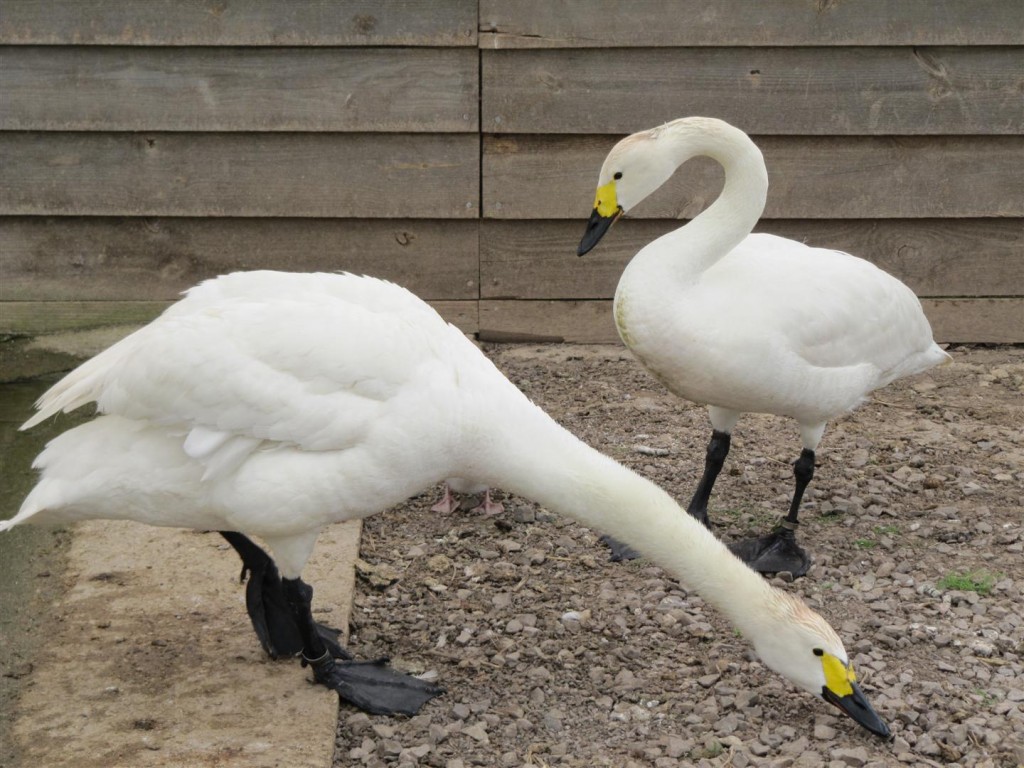Let's hear it for the boys!
Well having set aside a whole post last month in order to celebrate the efforts of the girls, let's re-dress the balance...
Just look at this male Hooded Merganser. No male sawbill puts quite as much effort into the vanity department as the Hoodie. The skull itself is probably one fifth of that fluffy mass and yet he is in control of every tiny follicle. It will never fail to astound me. Watching a Hoodie display on a sunny spring morning in a light breeze the crest will billow about, every tiny individual feather rippling on the scalp. Inevitably the crest is pretty near impossible to preen, and so towards the end of the breeding season they do lose control of it a bit, especially in dirty water... This proud chap has opted for the greased-up fringe, which might still be rectified with a thorough dousing in deep water and then a streamlined dive to shed the bubbles.
Looking pretty however is the one and only thing that a male Hoodie does for his partner. No protection, no incubation, no help. There are some species of wildfowl however whose males are equally fundamental to the rearing process as the females. I thought I'd give you a little slideshow of some dutiful and daring dads!
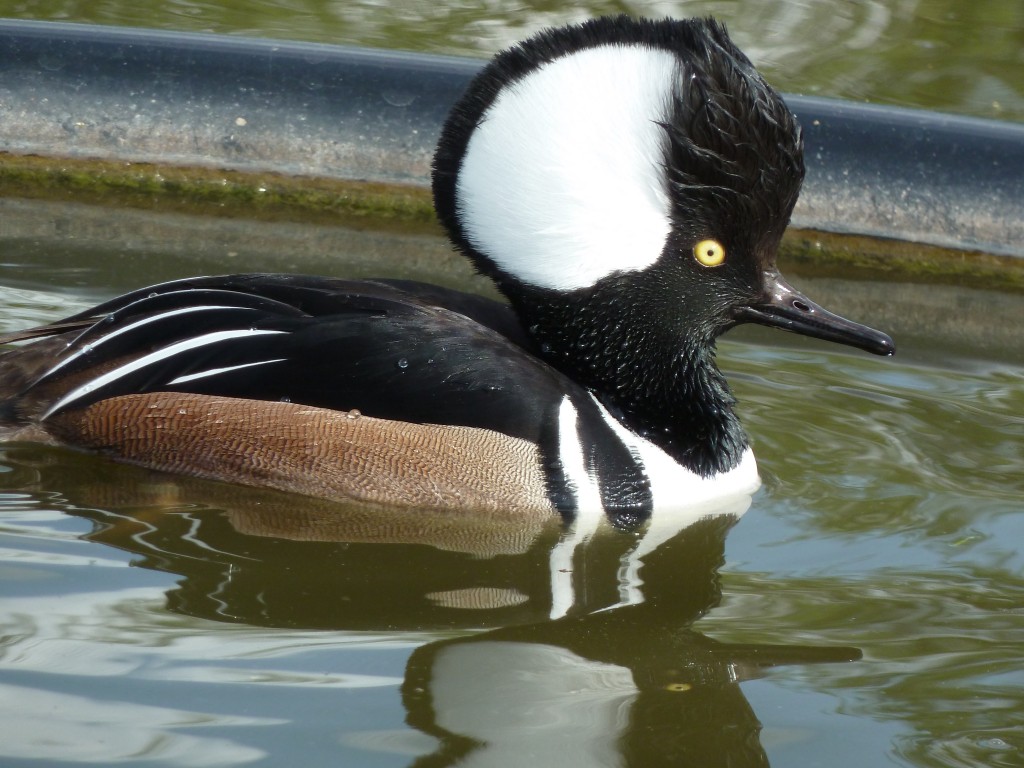
Geese are the most phenomenal parents as standard. Males and females pair for life, visit the same breeding grounds year in year out, will defend the nest directly, and will stand up to the most outrageous of threats from owls to foxes and even humans. Northern migrants will migrate south with their offspring, showing them the best stop off sites for "fuel stop" grazing. I can't think of a single goose species that is poor at parenting; from tiny black Brant through to monstrous African spur-winged geese.
Traditionally breeding females are dull in colour all across the wildfowl world so as to be naturally camouflaged on their nest, but in some sexually dimorphic species, they have developed some fascinating tactics in order to get around the camouflage dilemma.
Our male Orinoco goose is a stunning father. We have discovered this fact after an exceptionally sad turn of events led to the death of his beloved wife. Since this photo was taken back in June, this gorgeous guy has been rearing his 4 remaining goslings alone.
The male Orinoco is by no means camouflaged, but the goslings are. Striped like little humbugs, these goslings can dive into shaded areas and mix with the dappled sunlight when under attack, and black and white stripes can also work well on the water. Both male and female have hardened bone spurs on their wings which they can raise up and use in defence of their brood. Overall though, the Orinoco goose is not the most camouflaged nor beefy of birds, but thankfully, at Slimbridge none of this matters...
Mister has done a sterling job with his babes. Every time he sees me he lets out a warning whistle and they all dive for cover. When discovered, they skirt around the edges of their pen, him in front and the babes huddled behind his body away from my direct eye-line. When immediately cornered he will raise his wings and threaten me with head bobbing and honking, and when all is lost he will let out the "run for it" call! Catching them is required on a fortnightly basis, because as good as he is he cannot inoculate his babes for worms and parasites himself...
With any luck, we will soon put him back out on display, and he can show you all just what a good job he has performed alone. It is so nice to see a wildfowl father capable of doing it alone.
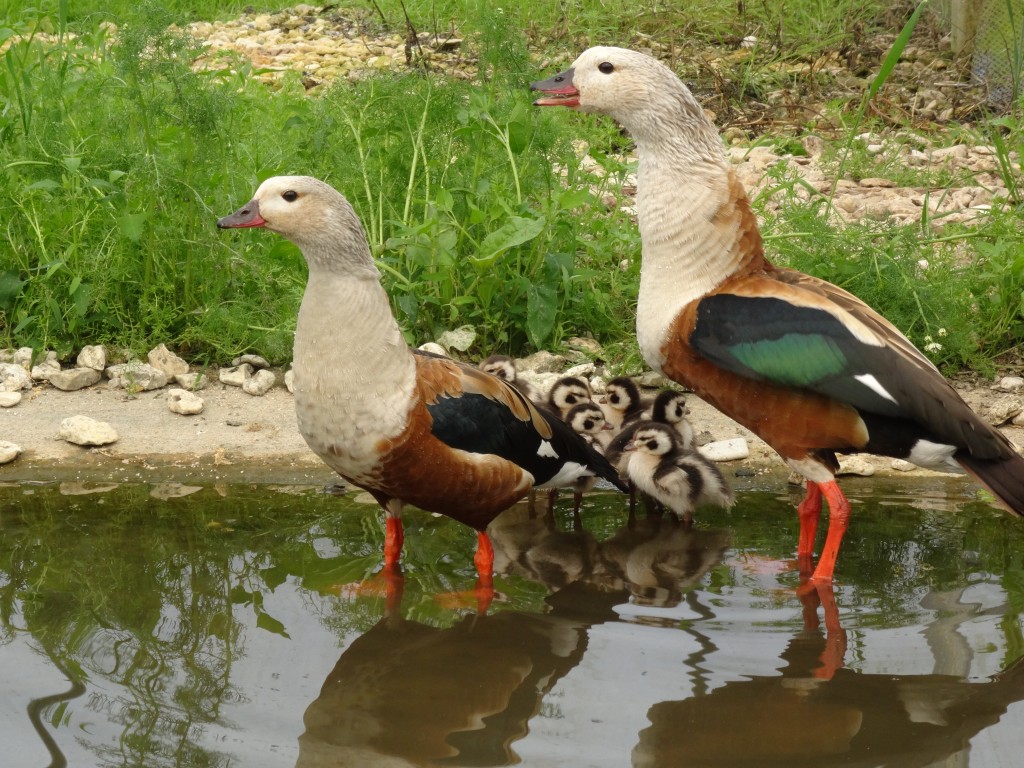
A male black Brant goose is a whirlwind of activity around a nest! Talk about noisy! These feisty little American geese have an amazing breeding story.
They begin in California and the southern states of America, and within a week can migrate at extraordinary speed and in great numbers up the wet coast into the Arctic circle and Alaska. This coastal goose sustains itself on nutritious seaweed, sea lettuce and coastal vegetation during this phenomenal migration. They fly fast and low over the water, and so are regular vagrants and get blown off course by weather systems.
They nest is loose colonies for protection in numbers, and interestingly will often nest within the range of a non-direct predator such as a snowy owl. This benefits them hugely during the incubation stage as foxes will not come in and eat the eggs due to the owl, but becomes a double edged sword for the first few days after hatch because the goslings will be owl-sized meals for around a fortnight. Can you imagine a male black brant dive-bombing a snowy owl? Amazing!
In captivity this wild instinct manifests itself in different ways. Much like Red-breasted geese their small Branta counterpart, they will make their nest in the open away from fencelines and in relative isolation. The male will charge at everything he sees fluffed up as big as he can be. Their captive technique is "I'm going to annoy you so much that you can no longer be bothered."
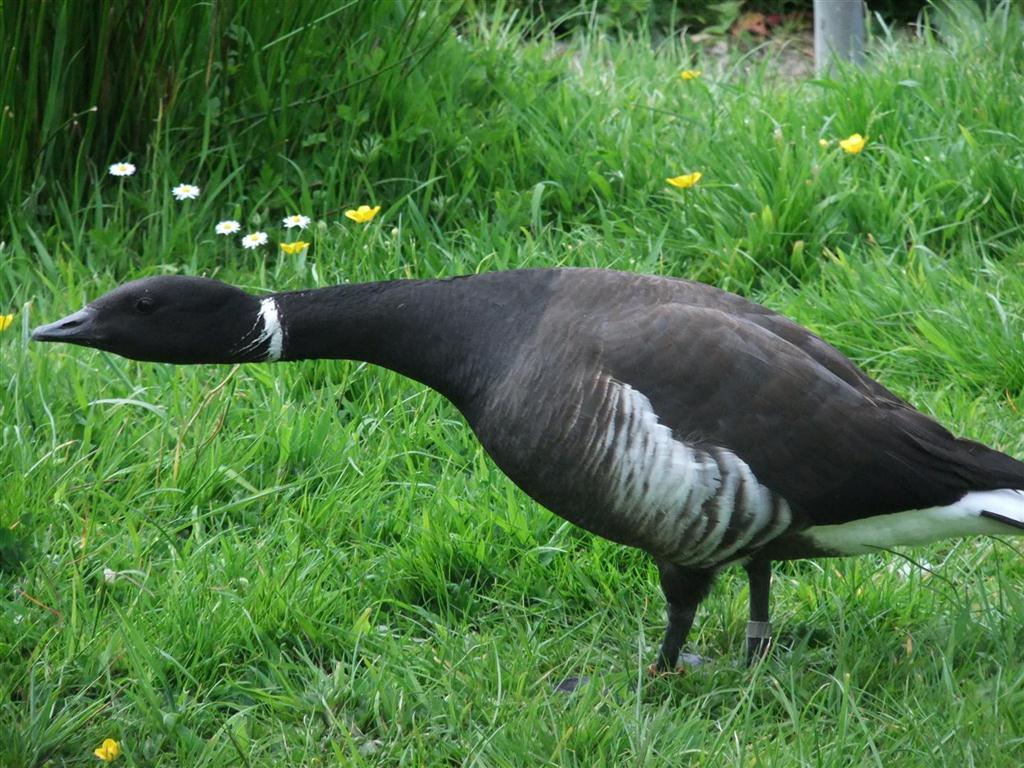
Nene give nest defence a go, but they never really approach the whole thing with a suitable amount of effort... In the end all they seem to do is give their female's nest camouflage away, and hiss like asthmatic grandpas. I love my Nenes but I've always thought they sound like a grandpa getting out of an armchair.
Some of WWT's brood of Nene have exceptional nest behaviour; others not so. BAN in particular quite regularly wraps is beak around the skin on my hands and gives it a good tug during the breeding season, but besides leaving a beak-shaped bruise Nene are pretty ineffectual nest defenders towards humans. So long as they can keep the corvids at bay however, I'm a happy bunny.
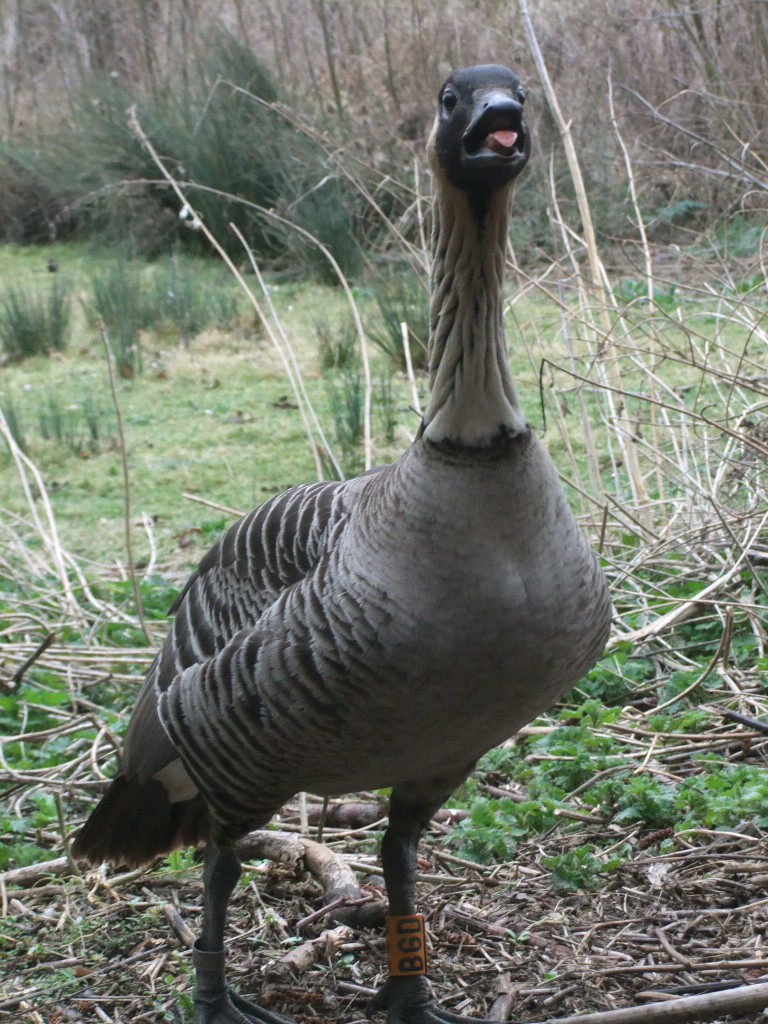
Our Magpie geese have had another good season and that is for one very good reason; teamwork.
These polygamous wonders use a group tactic to rear their young, dictated by hormones and territorial dominance. The male below has the darvic ring WAD and he is the sole controlling male force in the Australian side pen. As a result his hormonal crest is ridiculously rather large, showing just how important he considers himself to be in his direct relationships with the other birds. Despite his vanity WAD's success can be attributed to his stoic and devoted defence of his females coupled with his willingness to participate in the breeding process.
Magpie geese share laying and incubation duties. As a result, a "group" of 1 male and 4 females can have a nest with over 15 eggs in it! This is bad methodology however, and the reality is that the male only mates with the oldest and most "favoured" of his females. WAD has three favourites, and they can currently be seen in the Australian side pen with 3 healthy goslings. The reality is though that the nest probably contained well over 10 eggs.
The reason for poor overall success is that the Magpie geese just makes a nest out of a mountain of vegetation; anything goes. As a result eggs often get buried, rolled off, cracked and separated from the main mass. Their inelegant poise and big feet tend to get in the way and their blunt beaks are not very good at rolling the eggs back in. As a result, the typical magpie nest at Slimbridge is a bit of a messy affair... Everyone joins in though, and the photo below shows WAD taking his turn!
The reality is that if the maggies are too productive, long term fights and feuds can break about amongst the families. You have to be very special to get absorbed into a group, and because maggies live so long and mature so slowly, it will be a good 7 years before the babes are ready to mingle. They will be looked after devotedly for upwards of 8 months, but then the male will start to get pushy. As a result we remove juveniles before the winter kicks in, and make unrelated juvenile mixed groups off site to prepare for future breeding.
WAD is currently 21. He might have a couple of years left in him, or he might have a decade! Well done lad :)
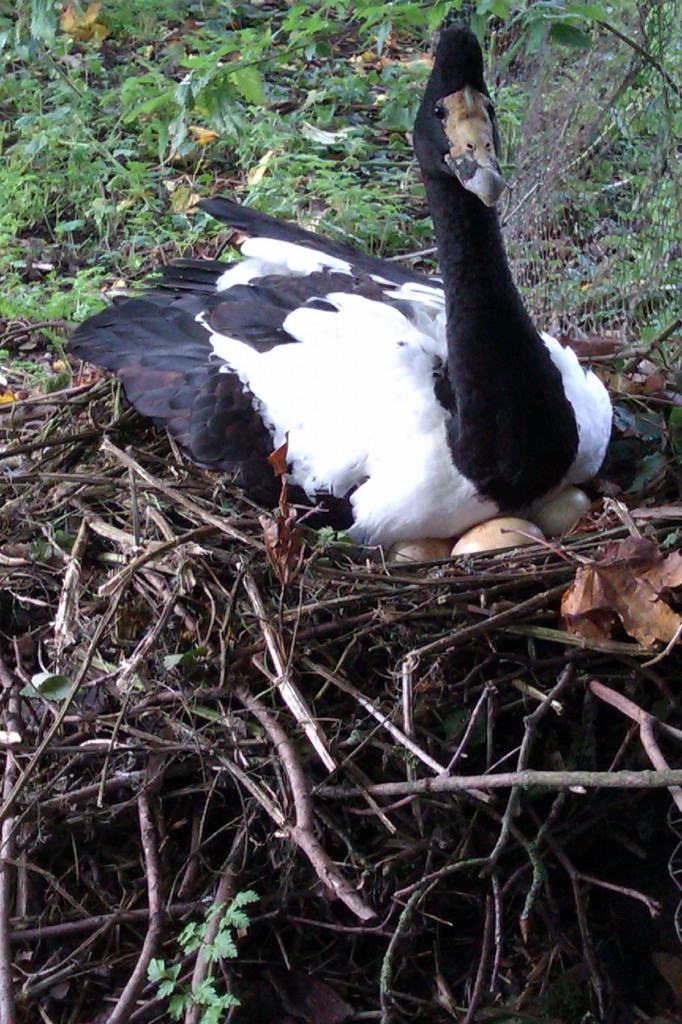
Lastly, a male Bewick swan takes cygnet defence very seriously indeed... can you spot the pink cygnet toes? Swans defend their nests and babes much the same as geese by creating an angry barrier between you and the cygnets, but with a lot more vigour!
Because the female has sat and incubated for 30 days, she allows herself a breather post hatch, and the male takes over the defence of the family. The key to any defensive father is the knowledge that nobody actually wants to make a move.
This photo was taken at feed time in the breeding season of 2012. He wants food and I need to feed it, so every day we performed an elaborate circular dance, where he didn't need to act and I didn't give him a reason to. We love and trust our swans and geese, and the only instance where we interfere is for worming purposes. Besides parasites, it's as natural as possible, all the way!
